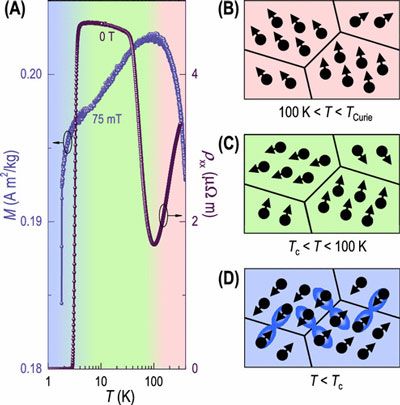| Posted: Jun 11, 2017 | |
Superconducting ferromagnetic nanodiamond films(Nanowerk News) Superconductivity and ferromagnetism are two mutually antagonistic states in condensed matter. However, Synthetic-doped diamond can be not only superconducting but also ferromagnetic. |
|
| In ACS Nano ("Superconducting Ferromagnetic Nanodiamond"), an international team of researchers has now reported on the investigation of the interplay between ferromagnetism and electrical transport in hydrogenated and heavily boron-doped nanodiamond (HBD) films, which have a Curie temperature of TCurie > 400 K. | |
 |
|
| Correlation between pxx(T) and M(T), indicating the electronic entanglement of the ferromagnetic and superconducting states and the presence of a precursor phase, in which spin fluctuations intervene for the development of the domain wall superconductivity at low temperatures. (A) The pxx(T) and M(T) curves are roughly divided into three regions (shadowed in red, green and blue, respectively) with respect to the temperature coefficient of pxx and M. The corresponding spin configurations are schematically illustrated in (B–D). (B) In the temperature window of 100 K < T < TCurie, the overall ferromagnetism of the system results from the ferromagnetic arrangement of the domains (domain walls represented by the black lines). (C) The precursor phase emerges in the temperature window of Tc < T < 100 K, where spin fluctuations intervene in the system via antiferromagnetic arrangement of the domains. (D) When T < Tc, carriers with antiparallel-aligned spins can be an additional source for Cooper pairing (opposite arrows bound by blue ∞) at the domain walls, in addition to the boron-doping-induced superconductivity in the HBD. (© ACS) | |
| The authors write that, in spite of the presence of the ferromagnetic ordering, the superconducting state still develops in their HBD films at Tc ∼ 3 K. The magnetization and resistivity data of the HBD demonstrate at different temperatures important correlations, suggesting spin-dependent electrical transport and possible Cooper pairing due to spin fluctuations in the HBD films. | |
| They also point out that the significant magnetic remanence well above room temperature, the anomalous Hall effect, and the giant positive low-field magnetoresistance observed in these HBD films bring attention to the potential applications of this material in different areas, e.g., magnetoelectronics, spintronics, and magnetic field sensing. | |
| "Most importantly" as the authors conclude, "the ferromagnetic ordering with TCurie > 400 K and the superconducting ordering with Tc ∼ 3 K, proven to be electronically entangled with each other, make our HBD also an interesting platform for investigating the competing interplay between the two antagonistic strongly correlated states of condensed matter." | |
| "Our data indicate the presence of a precursor phase, in which spin fluctuations intervene and contribute to the superconducting transition at lower temperatures," they continue. "The significant difference between the starting temperature of this precursor phase (∼100 K) and Tc, however, raises an important question, i.e., how does a ferromagnetic superconductor such as our HBD 'foresee' its low-temperature superconducting 'fate' and start 'preparing' for the superconducting transition via antiferromagnetic arrangements of the magnetic domains at a much higher temperature?" | |
| More thorough local measurements, i.e., mapping of the spin polarizations and the density of states in the precursor phase, and theoretical modeling are needed to solve this mysterious problem. |
Source: American Chemical Society
 By
Michael
Berger
– Michael is author of three books by the Royal Society of Chemistry:
Nano-Society: Pushing the Boundaries of Technology,
Nanotechnology: The Future is Tiny, and
Nanoengineering: The Skills and Tools Making Technology Invisible
Copyright ©
Nanowerk LLC
By
Michael
Berger
– Michael is author of three books by the Royal Society of Chemistry:
Nano-Society: Pushing the Boundaries of Technology,
Nanotechnology: The Future is Tiny, and
Nanoengineering: The Skills and Tools Making Technology Invisible
Copyright ©
Nanowerk LLC
|
|
|
Subscribe to a free copy of one of our daily Nanowerk Newsletter Email Digests with a compilation of all of the day's news. |
